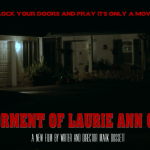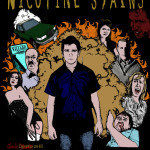
Tony (written and directed by Gerard Johnson) is a movie exactly about what it is sometimes subtitled–a “London Serial Killer”–ironically, far from the banality implied. As the tagline says, “It’s always the quiet ones.” Yes! If ever there was a misfit man who could be a killer, flaunting his psycho profile to the world, all the while looking utterly harmless, it would be a man like Tony–in his physical appearance, as much as in the way he behaves, seemingly too cliched to be true. From the tagline, as well as Tony himself, comes one of the most terrifying portraits of insanity I’ve seen. While flawed and tedious at times, Tony delivers real-world horror, all the more horrifying in its banality.
As for serial killers, Tony (played by Peter Ferdinando) doesn’t fit the classic profile in at least one important way. Rather than choosing his victims for the sake of killing, he mostly kills only to get even with someone who has offended him or posed a threat. Furthermore, Tony kills for the reasons he does, spontaneously, out of opportunity, in the proper place and time, rather than out of a meditated, contrived plan to do so. If it is safer to stay away from a potential victim, he does. If a person is nice to him, he never seems motivated to kill, while always assessing them as a threat. Tony’s need to kill (as he considers it a need) results from his attempts to socialize, often in dangerous situations, and his inability to deal with the consequences. The movie is more suspenseful in the beginning, before we see that Tony’s killing habits are more or less predictable. After the first couple of people who could be victims aren’t killed, we know that nice people live; after his encounter with the first few offenders, we know that they die. In knowing, one of the major intrigues of the movie is lost. Why haven’t I covered the basic plot synopsis by now, you wonder. Actually, I have. As viewers, we learn about Tony (and only Tony), as we follow him around, observing his behavior. Thus, Tony’s behavior, as random as it is, is the best substitute for a plot we have.
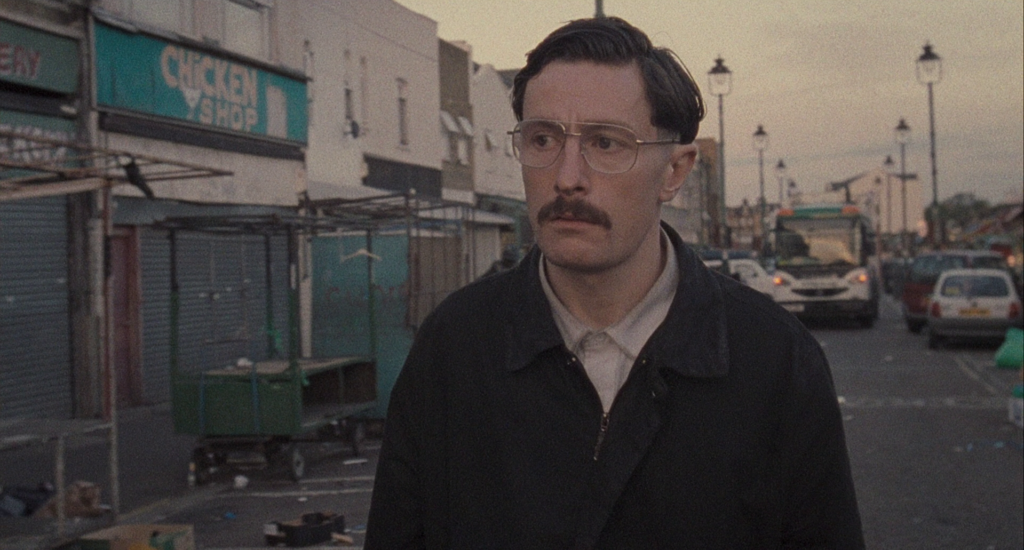
Tony (Peter Ferdinando) walking the streets, looking for anything to connect with the world.
More odd realities we observe include the fact that Tony is a lifetime “jobseeker,” as the British apparently call the unemployed. He has been without a job, drawing shoestring unemployment benefits for 20 years, living in housing conditions that are best described as bare bones, at worst described as deplorable. While the outside of his housing complex looks like a hive, it is ironic that he communicates and effectively socializes with no one…other than those who impose upon him. Tony happily accepts his conditions, shuns work, and seems to thrive, rather than stagnate, watching videotapes on a TV the size of a microwave oven. The banality of his environment and minimal possessions mirror his equally empty, mundane character, while not serving the same metaphor for his contentment with it all. Yes! Tony is an analogy with his surroundings and his life in general–an analogy only the viewer sees as unfortunate.
“You’re not a solder. You’re a fly on a piece of shit.” ~ Tony
With closer scrutiny, Tony is also an odd combination of eccentric, conservative behaviors and attractions to the seedy side of life. Squash (fruit juice diluted with water) is the only drink he keeps on hand; he avoids alcohol, but seeks drugs from addicts. While Tony seems almost asexual, he visits gay bars and whore houses, although more out of curiosity than real interest. With these contrasts, the duality and complexity of his character is further revealed. In a schizophrenic conversation Tony has with himself in the mirror, he first says, “I’m a soldier. And I deserve to die like a solder.” Then, he says, “You’re not a solder. You’re a fly on a piece of shit,” (and then he screams at himself). Here, we see the dichotomy and derangement of Tony’s personality explode, with even greater impact. Yes! Tony’s sudden self-awareness, followed quickly by calmness is chilling, possibly more so than his behavior otherwise! Here, we see the monster within him, self-aware within a facade, all the more dangerous with its deception.
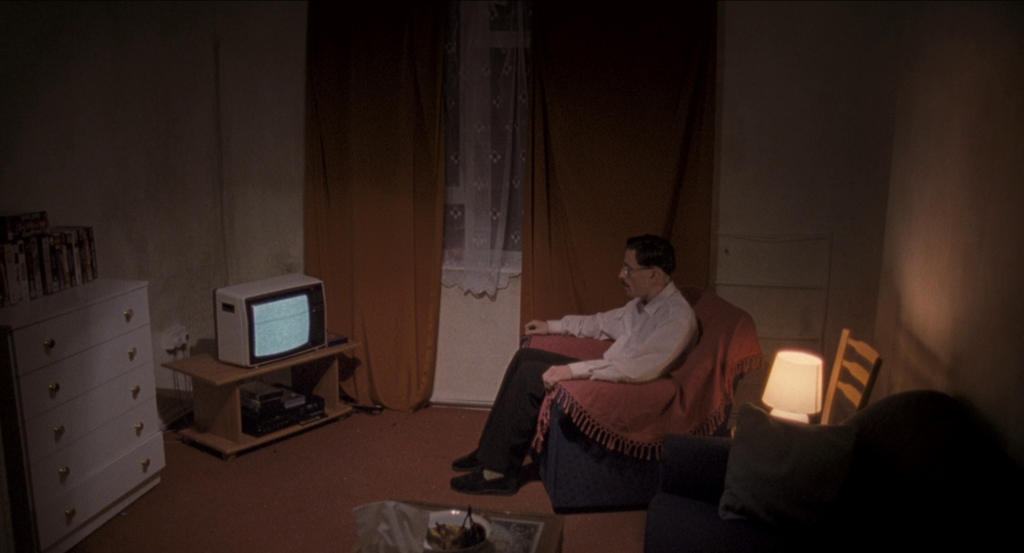
Does a man’s surrounding define his personality? In Tony’s case, yes!
Other people in the movie, rather than characters, are mostly just those who inhabit Tony’s world, truly as generic as their credits suggest: DVD seller, Davey’s Mum, Davey’s Dad, Drug Taker, Dealer, Pub Regular, along with a few insignificant names. Instead of being characters on their own, we only know them in the ways they relate to Tony. This miopic perspective helps to keep viewers isolated, in the way Tony is isolated himself; this way, we only occupy Tony’s world and, in an unsettling way, his mind and way of thinking. With this perspective we are further unsettled to feel, in some way, at least a hint of compassion for Tony, seeing his motives for killing as a likely defense mechanism for the often abusive world he inhabits. While we surely don’t agree with his choices to murder, his victims help us see beyond the typical reasons: murder for the sake of murder, or murder for simple gratification or pleasure. Yes! So many generic, obnoxious characters overall bring us a bit too close to Tony for comfort…and all the more horrifying for us!
The character (or inhabitant of Tony’s world) that is most interesting is one about which we learn the least…and, in fact, never see at all. Inside his apartment, in a closet, is apparently a victim being held as a captive. I would say it’s a figment of Tony’s imagination, if it was not for the fact that he (yes, I believe it is a male for some reason) makes noise that is heard by others, including us. We even see Tony’s living room area, from inside the closet, from the perspective of whoever it is. Viewers can only assume that this is a victim who is, so far, being kept prisoner. While this is intriguing during the movie, it is frustrating in the end, as a mystery likely never to be solved. (Yes! I’m thinking that the chances of a Tony 2 at this point are about 0.) While some leftover mysteries are intriguing, this one makes the movie seem more incomplete, more like a long short film.
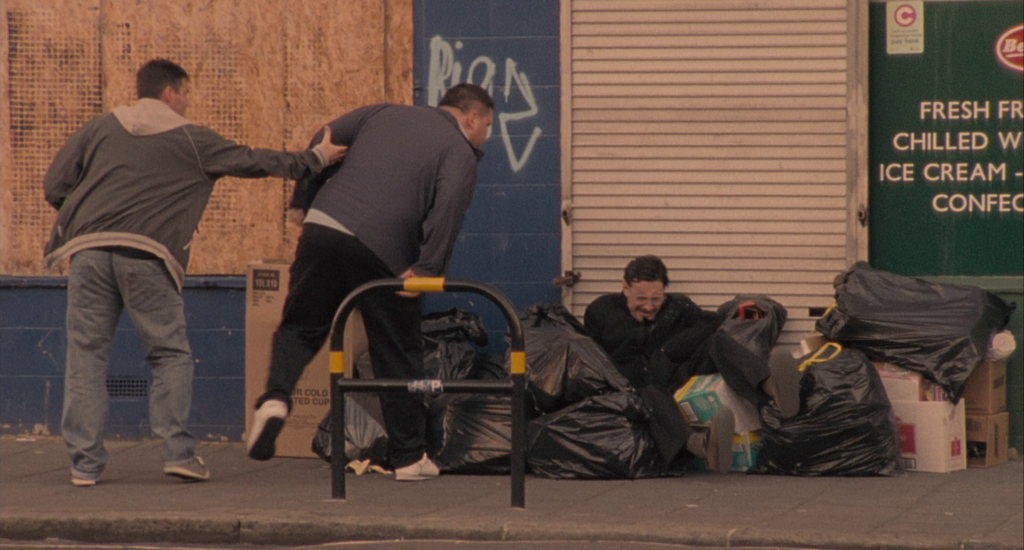
As we know from watching horror movies, abusing a psycho is never a good idea!
Peter Ferdinando does an awesome job of making Tony a character of his own invention, perfected in a way that no other actor could duplicate. After seeing the movie, I cannot see it being made with anyone else in the lead role. Fernanado makes Tony a character study–blazingly personal and authentic–as much as it is a movie about a serial killer. Ferdinando’s Tony is timid and socially pathetic, yet suddenly violent and murderous, followed by apathy and utter detachment–a classic sociopath, for sure. Without such a powerful performance, Tony would be a flop. Such a character-driven movie must have an actor like Ferdinando, revealing complexity and depth with every move and expression, subtly, with the most ordinary actions. Kudos to Ferdinando for being Tony with perfection!
Is Tony a gory movie? That depends on your sensitivity to meat (that is suggested to be human) cut up in a kitchen, as one would slice up a chicken for dinner. While it’s certainly animal meat, the imagination makes it human, in context. Gory? For many, yes! Cuts of meat look more human than animal in a movie about a serial killer, regardless of their origin. However, a particular off-screen bludgeoning, with hard-hitting sound effects, is more gruesome than blood or gratuitous lingerings on meat could ever be. Off-screen sawing and dismemberment remind us that less is truly better in certain cases. Unexpected closeups of body parts add effective visceral moments and shocking reminders of what is hidden.
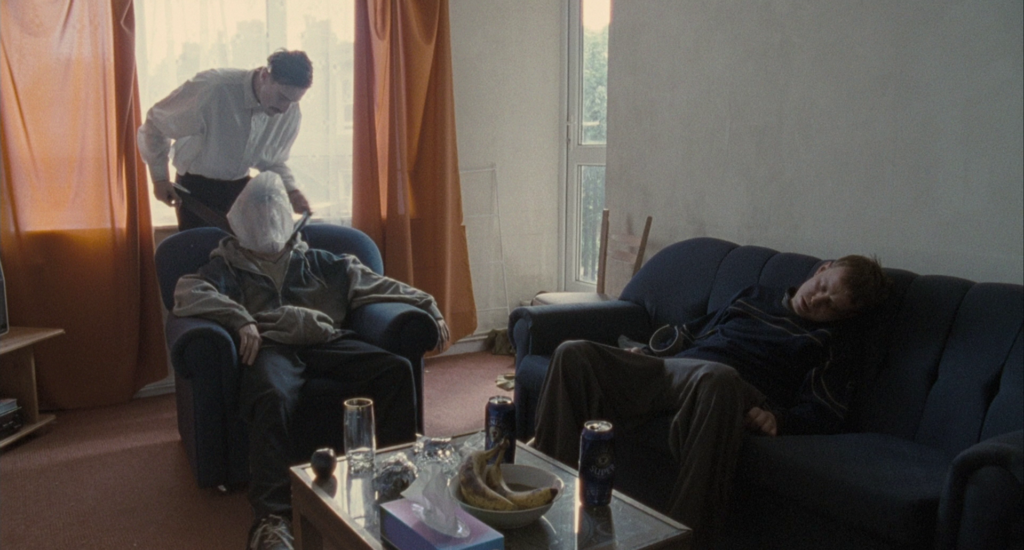
Taking a nap at Tony’s house may be the last nap you ever take!
In some ways, Tony plays out like an overly-long short film. Although its running time is only 72 minutes, it never delivers as much as possible. Rather than advancing the story, we mostly just see more and more of Tony’s deranged, often homicidal habits. Certainly, there is an effective, ongoing creepiness to the monotony of his behavior and killing, but the payoff for viewers is limited. Instead, Tony is a slice-of-life story, possibly too truncated, revealing too little to satisfy some viewers. The final frustration is the end–essentially a continuation of the beginning, after making us privy to Tony’s serial-killer tendencies (although wanting more could, indeed, be the greatest compliment.) Beyond the end, we should see police investigation of missing victims, as well as the results of Tony’s flawed habits of victim disposal. Further beyond the end, we should see the end of a killer, brought down by his own carelessness. As it is, we meet Tony and what he does, for the time he does it, suggesting, finally, that it could go on forever.
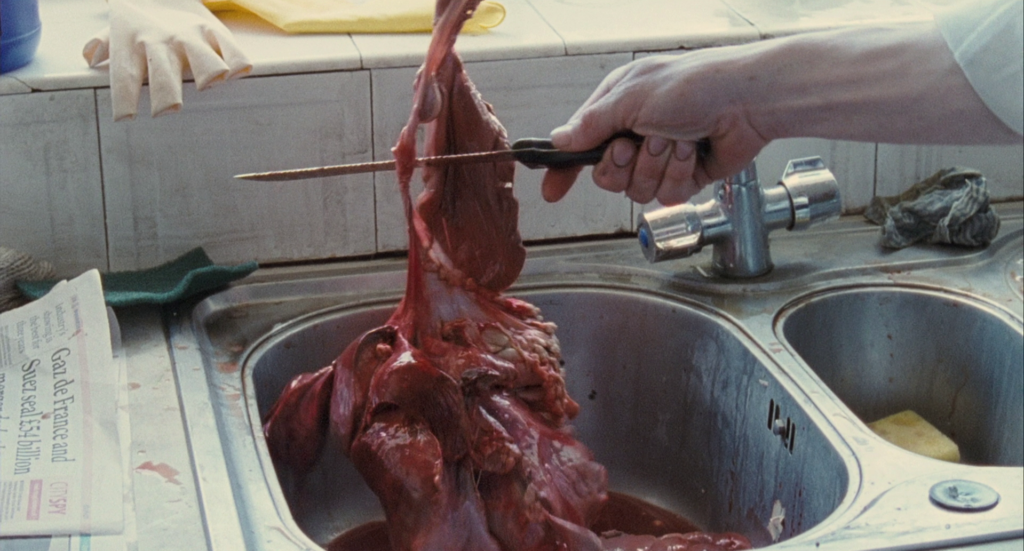
What’s for dinner at Tony’s? The answer requires no menu!
Is Tony worth watching? Absolutely! Even with some shortcomings (as most movies have), Tony stands out as one of the most realistic films of its kind. The most effective horror of the movie comes from the viewer’s realization that this is the way a real killer would behave, kill, and hide in our own city, neighborhood and, perhaps, in a house next door. Henry: Portrait of a Serial Killer is one of the best movies I can think of, in a comparison for realism. As a human, Tony is strikingly banal, yet outstanding as an aberration; the contrast screams at audience’s, with horror that chills us to the bone. Absent here are slick Hollywood sets and polished production values that would remind us that it’s fiction. A particular scene where a plastic shopping bag sticks to Tony’s hand in the kitchen (as he uses it for a gruesome purpose) was not cut out or reshot. Instead, we see exactly what we would see a real person experience (handling a shopping bag, that is), every day. Other scenes where Ferdinando makes small mistakes delivering lines (such as repeating a word) are left in, unedited for realism, adding to Tony’s character. It is subtleties like this that add volumes to Tony‘s authenticity and effect. Whether left in for budgetary reasons, or out of a conscious plan for realism, it works perfectly.
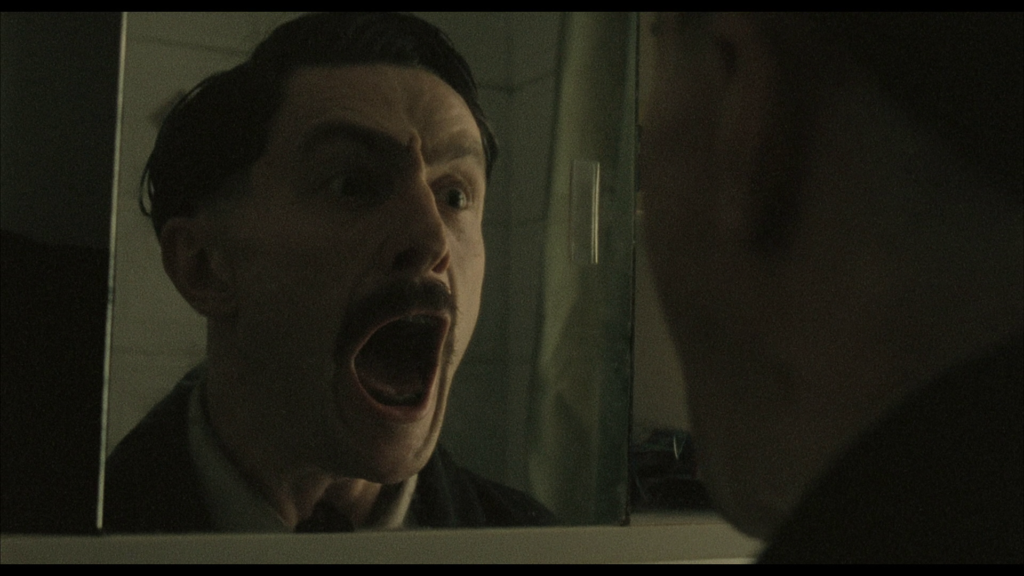
“You’re a fly…on a piece of shit,” says Tony, with a mirrored scream of fecal awareness.
Do questions remain, when the credits roll? Yes! A lot! Will Tony every get caught? (He cleans up afterwards, but dropping bagged, floating remains in the local water system should catch up with him, sooner or later.) Will anyone ever look for the missing people he kills? Will the trail of the dead ever lead back to him? Will anyone who investigates him live to leave his apartment? Does Tony eat any of his victims? (It is only implied that he does.) Will Tony ever get a job? Or, will he kill every social worker who handles his case, drawing unemployment for the rest of his life? Will Tony ever convert his videotape collection to DVDs (or Blu-rays) and get a flat-screen TV? Will Tony ever have sex and, perhaps, find something in life better than killing people? Oh, the questions!
With or without questions, Tony is a raw, gritty slice-of-life terror tale, immersing us in isolation, insanity, and murder…all in the most ordinary way. If that’s not enough to make you feel the horror, see the movie. Nothing anyone writes can communicate Tony‘s effect as well as it is delivered by the movie itself. While that can be said of any movie, it is ever more truly said of this one. While “keeping a neighborhood watch,” as the movie poster recommends, Tony is definitely one not to miss!

Rocket Rating – 7
Chris Rennirt (the author of this review) is a movie critic and writer in Louisville, Kentucky, as well as editor in chief at Space Jockey Reviews. He has been a judge at many film festivals, including Macabre Faire Film Festival and Crimson Screen Film Fest, and he attends horror and sci-fi conventions often. Chris’ movie reviews, articles, and interviews are published regularly on Space Jockey Reviews and in Effective Magazine. His mission statement (describing his goals as a movie critic and philosophy for review writing) can be found on the “Mission” page, here at SJR. For more information about Chris Rennirt (including contact details, publicity photos, and more), click here.
You may also like these!

